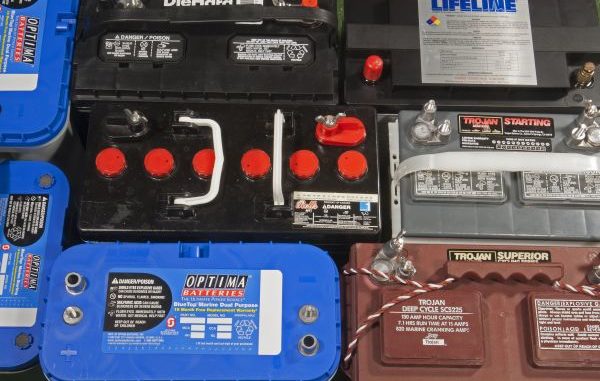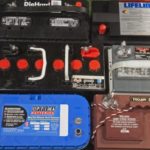
Lack of care hits you in the pocketbook
Learning that all batteries are not created equal can be an expensive lesson. Power your trolling motor with batteries designed to start your engine and they will last for weeks rather than years. Buy full-maintenance batteries and treat them like maintenance-free versions and you will be lucky to get a single season out of them.
Here is the commonsense approach to battery buying that has saved me time, effort and money for nearly four decades.
Lead-acid batteries deliver power as the acid in their electrolyte combines with the lead in their plates during discharge. Recharging the battery drives the acid out of the plates and back into the electrolyte.
The amount of power a battery can produce is related to the amount of plate surface area it keeps in contact with its electrolyte, and the construction of those plates dictates how well it handles heavy deep-cycle use.
Engine starting calls for batteries that can produce a lot of power in a hurry. So-called “cranking” batteries are therefore built with a large number of comparatively thin plates to maximize the amount of plate surface area in a conveniently-sized case.
These batteries use a large portion of their capacity to start your engine, and then are quickly replenished by the engine’s charging system.
This kind of a discharge/recharge situation is considered a shallow cycle.
Your engine’s owner’s manual contains an MCA (marine cranking amp) rating that a battery must have to reliably start the engine under normal conditions. This rating (sometimes called just “cranking amps”) is the number of amps a 12-volt battery can deliver for 30 seconds at 32 degrees Fahrenheit while maintaining at least 7.2 volts.
The larger this rating, the bigger the engine a battery can start; however, buying a battery with a higher-than-called-for rating means it will start your engine better in cold weather and continue to do a good job closer to the end of the battery’s life.
Settling for a battery that barely meets the manual’s recommendation also does not guarantee reliable starting after it powers a fishfinder, chart plotter and radio for several hours.
This brings another rating called RC (reserve capacity) into play. This gives you the number of minutes that a fully charged battery will deliver 25 amps at 80 degrees Fahrenheit and maintain a terminal voltage of at least 10.5 volts.
Cranking batteries aren’t designed to carry accessory loads for long periods of time when the engine isn’t running, and many don’t have RC ratings on their labels.
Deep-cycle batteries are designed to carry accessory loads, including the heavy loads of electric trolling motors for long periods and then be recharged at the end of the day. These comparatively deep discharge/recharge cycles give deep-cycle batteries their name.
Deep cycling is hard on battery plates, so these batteries have fewer but thicker plates than cranking batteries in order to survive the extra stress.
The RC rating is useful for comparing deep-cycle batteries, and more is better. I’ve never heard a fisherman come back to the dock complaining about having too much power left; it falls in the same impossible category as having too much good luck and too many tax deductions.
Many anglers prefer to use a tape measure instead of power capacity ratings and simply install the largest and heaviest deep-cycle batteries that fit in their battery compartments without unbalancing their boat.
Buying larger deep-cycle batteries than you might need on an average fishing day makes them last longer. The total number of discharge/recharge cycles a new battery can deliver is considered the length of its service life, and the shallower each cycle is the more cycles it lasts.
For example, a battery might be designed to survive 200 fully discharged and properly recharged cycles. This means running the battery down until the prop on your trolling motor stops turning and then recharging it at an amp-per-hour rate that is 10 percent or less of the battery’s total capacity (a 10-amp charging rate or less for a 100 amp-hour battery).
This same battery might last 650 cycles if it is only discharged 50 percent on each fishing day, 1,500 cycles if discharged only 25 percent and 3,500 cycles if discharged only 10 percent.
So, if you are looking at the lower price tag on a 75 amp-hour battery that will be discharged 50 percent or more each day and thinking it’s going to cost less in the long run than a 100 amp-hour battery that will be discharged less than 50 percent each day, the odds are that you are wrong.
This same principle applies to selecting trolling motors. A 24-volt motor draws slightly less power from each of its two series-wired batteries to produce a certain level of thrust than a 12-volt motor draws from two batteries wired in parallel to reach the same amount of thrust. And, a 36-volt motor pulls even less from each of its three series-wired batteries.
Drawing less power from each battery for the same amount of motor performance means a shallower discharge and longer battery life, not to mention a longer motor-running time on a single charge when you need it.
This is why you see pro guides and tournament anglers running 36-volt motors on boats that could easily be propelled by 24-volt models.
The amount of maintenance a battery requires can also affect its longevity, especially if you don’t keep up with it. Flooded-cell, full-maintenance batteries give you more amp capacity per pound of battery weight and per dollar of cost than any other type. But you have to check the six cells in each battery and make sure they contain enough water to cover their plates after every trip.
These batteries use water as a normal part of the discharge/recharge process, and if a cell gets low after a hot summer day or two on the lake and you don’t notice it, the exposed plates in just one cell can warp and kill the battery.
These batteries must also be recharged promptly after each trip and be maintained at 75 percent of a full charge between trips or you risk plate sulfation (the formation of crystals on the plates that insulate them from the electrolyte, making the covered areas unusable).
Most marine batteries are killed by sulfation long before their components wear out.
Some of us hate dealing with the messy maintenance required by full-maintenance batteries after a hard day on the lake, especially if we have a boat with poor battery compartment access. If you know you aren’t going to keep up with a high-maintenance flooded battery ,stick to one of the other types.
AGM (absorbed glass mat) batteries are the most popular maintenance-free type. Their positive and negative plates are separated by a tightly packed spongy material that absorbs the electrolyte, leaving no liquid in the cells. An AGM battery can’t leak even if its case is punctured.
This battery type generally has less internal resistance, and can deliver power and be recharged faster than a flooded, full-maintenance model. If there is a downside to them it’s that they are slightly heavier and more expensive than flooded batteries with similar MCA and RC ratings.
AGM models are often called “gel cell” batteries by mistake. Gel batteries are quite different; they are filled with liquid electrolyte at the factory, and silicates are then added to turn the liquid into a gel. They are sealed and can’t leak, just like AGMs. And they, too, are maintenance-free.
Like AGM’s, gel batteries must maintain a slight amount of internal pressure to operate. Both types are protected by pressure-relief valves that prevent over-pressure case ruptures should a catastrophic internal failure occur.
Gels are famous for having a long shelf life and for resisting sulfation. On the negative side, gels are heavier and more expensive than AGMs, and require a special charging profile. A charger designed to fully charge a flooded or AGM battery is too hot for gels, and can cook one in short order.
The bottom line: Buy good, quality batteries to begin with and choose the type you are most likely to maintain properly, and treat them like the investment they represent.




